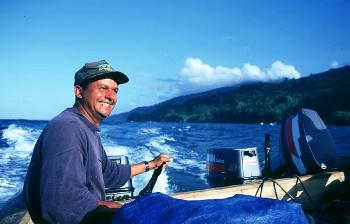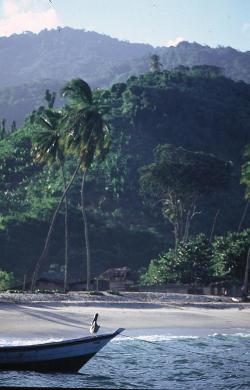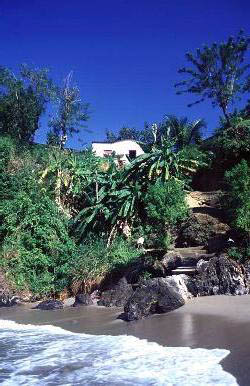| IN THE WAKE
OF COLUMBUS
A journey along Paria's
wild shores
 The
coast of the Paria Peninsula remains one of the most pristine
and untamed corners of the Caribbean. East of the one-telephone
town of San Juan de las Galdonas, the coastline stretches
wild and wooly to the country's eastern tip, a gull's glide
from the islands of Trinidad and Tobago. The
coast of the Paria Peninsula remains one of the most pristine
and untamed corners of the Caribbean. East of the one-telephone
town of San Juan de las Galdonas, the coastline stretches
wild and wooly to the country's eastern tip, a gull's glide
from the islands of Trinidad and Tobago.
From the point known
as Boca de Cumaná, an hour's boat ride from San Juan, the
Parque Nacional Península de Paria begins, harboring rich
cloudforests which rise to over a thousand meters.
As one
travels east, Nature slowly but remorselessly takes back what
was once hers. Toe-hold settlements at the mountains' feet
begin to peter out. Traces of human impact - the odd forest
clearing, the occasional zinc roof - become less distinct.
Gradually, only the crenellated spines of the mountain range
remain. The forest's pelt muffles the valleys. Trees and palms
quilt the crests of hills like hairs on a pouncing cat's back.
Rivers disgorge onto palm-lined beaches or chute from rock
faces into the turquoise waters below. Frigate birds, cormorants,
terns and pelicans hover and swoop. The land becomes as Columbus
would have seen it, over five hundred years ago.
BOTUTO AND ROBIN
 Few
men know this coast well. Fewer still as well as Botuto, the
fisherman-teacher who would be our captain, guide, cook, fish-spearer
and source of much laughter over the next three days. Botuto
is Spanish for 'conch'. His real name is Clemente, but the
name really doesn't fit the man. With his proclivity for diving
to dim depths recognized from an early age, one of his brothers
came up with this more appropriate sobriquet. While his enthusiasm
for the natural panorama is infectious, his love for the sea
verges on the unhealthy. He'll skin-dive to 20 or 30 meters
in search of grouper the size of sharks, or lobster weighing
more than small children. He's proud that no-one in the area
can dive deeper or for longer. Like all fishermen, his arms
tend to elongate with every telling, but what's a few inches
between friends when you're presented with a freshly-speared
dinner of lobster, red snapper and mussels? Few
men know this coast well. Fewer still as well as Botuto, the
fisherman-teacher who would be our captain, guide, cook, fish-spearer
and source of much laughter over the next three days. Botuto
is Spanish for 'conch'. His real name is Clemente, but the
name really doesn't fit the man. With his proclivity for diving
to dim depths recognized from an early age, one of his brothers
came up with this more appropriate sobriquet. While his enthusiasm
for the natural panorama is infectious, his love for the sea
verges on the unhealthy. He'll skin-dive to 20 or 30 meters
in search of grouper the size of sharks, or lobster weighing
more than small children. He's proud that no-one in the area
can dive deeper or for longer. Like all fishermen, his arms
tend to elongate with every telling, but what's a few inches
between friends when you're presented with a freshly-speared
dinner of lobster, red snapper and mussels?
Botuto,
with his round face always about to break into a smile and
his belly one crate of Polarcitas away from a barrel, has
taught in most of the villages and hamlets that cling to these
wild shores. As we set out from San Juan in his 10-meter wooden
launch on a clear, crisp morning, he hugged the shoreline
like an old friend. We passed a village called Tacarigua.
Public transport along the coast is non-existent. You have
to hope for a ride from a passing fishing boat. At Tacarigua,
Botuto would swim 300 meters out to a rock, his pupils' schoolwork
carefully waterproofed and wrapped around his waist. There
he would wait all day for a lift. On a few occasions, when
none appeared, he'd have to swim back.
Botuto
was ably assisted by a towering, six-foot, black-as-night
fisherman called Toto (real name: Robin). Toto's voice boomed
from his large chest. When we first met him, his manner verged
on the rude. He swung, surly, in a hammock and glared at us.
But as we took to the sea, and the banter between them flew,
Toto turned out to be quite the opposite. He told us about
a fishing trip when he'd accidentally shredded the engine's
fuel cable - not exactly confidence-inspiring. He and his
companions had languished adrift for four days. They survived
by scooping sardines overboard and rationing water down to
a few drops. Eventually another fishing boat caught sight
of the signals they'd been sending - from the polished lid
of an old tin.
Throughout the days languishing at sea, Toto
said he'd sung and prayed, trying to remain positive. His
friends, convinced they were all going to die, and unable
to understand how he could sing about it, nearly lynched him.
His boat was eventually towed to Isla Blanquilla, an offshore
island some 400 kilometers from San Juan.
COLUMBUS' PARADISE
 Always keeping close to
the shore, we rode the swells in and out of the jaw bones
of bays whose tumbling hills would end in island incisors
and molars. Atop these blanched rocks, colonies of torpid
pelicans would preen. Occasionally, one would fly over to
the guano-bleached eaves of nearby trees, or dive into the
rolling waves. Always keeping close to
the shore, we rode the swells in and out of the jaw bones
of bays whose tumbling hills would end in island incisors
and molars. Atop these blanched rocks, colonies of torpid
pelicans would preen. Occasionally, one would fly over to
the guano-bleached eaves of nearby trees, or dive into the
rolling waves.
We passed the isolated house of the "Cuaima
de la Frontera", Alcadio Arcía. Of Trinidadian parentage,
like most of the inhabitants of the coast, people came from
all over to visit this old hermit. He was a master of galerón
songs, an inventive, playful 12-line form, sung throughout
Venezuela. Alcadio had won nationwide competitions, Botuto
recounted. More remarkable than his choice of back garden
was the fact that he couldn't read or write.
About
two-thirds of the way to our destination of Uquire, we stopped
for some snorkeling. Botuto donned his wetsuit, weights, mask
and fins. I settled for a mask and fins. We dove off in the
lee of a calm bay, the midday sun casting rays through the
blue-green waters, illuminating the maze of rocks and shoals
of colorful fish below. On the first dive, I stuck with Botuto
to about ten meters, pushing back the pressure in my ears.
We then swam further out. There, we dove again and Botuto
just kept going and going and going. Short of breath, and
getting claustrophobic, I struggled back to the surface. And
waited and waited and waited. I was on my way down again,
some two minutes later, before Botuto came shooting up from
beneath me.
SAVAGES
As
proficient as he was underwater, Botuto readily admitted that
he was useless in the forest. Above five hundred meters, Paria's
cloudforest is a dense, dark, scary place. Only the locals
know their way through the jumble of jungle vegetation. And
even then, they still get lost. Walking barefoot and shirtless,
with their packs of hunting dogs yapping ahead, Botuto had
the utmost respect for the men who had to spend the night
in the forest, alone, having lost their way in search of game.
The woods are still rich in brocket deer, tapir and paca,
but also less fluffy residents: grunting peccary and snarling
jaguar.
Paria's forests are also renowned for the number of
poisonous snakes which cross the paths of unsuspecting hunters.
Just the Latin name for the fer de lance - Bothrops Atrox
- sends shivers down your spine. The nearest hospital is leg-amputating
distance away. At dawn in Uquire, we awoke to the guttural
groans of red howler monkeys echoing across the bay. Botuto
told how he and a group of tourists had once spent the night
on a beach on constant paranoid watches, convinced the howls
were those of jaguars.
The
early explorers of these shores were no less prone to exaggeration
and flights of fancy. Arawaks and Caribs inhabited Paria's
coast when Christopher Columbus, Amerigo Vespucci et al first
arrived. The Acios of Arawak descent were at the time buckling
under the aggressive expansion of the Carib Pariagotos, from
whence the name of the region: paria meant 'mountain'. These
two races, one peace-loving, the other bellicose, aptly illustrate
the divided European reaction to the people of the New World.
 The Caribs (called canibales in Columbus'
journal) provide the source
of the word 'cannibal' and the myths surrounding the savage,
wild men which fitted so snuggly into the Elizabethan pageant
of ghouls and demons. Shakespeare's Caliban in The Tempest,
for instance, is a neat anagram of cannibal. As one historian
has noted, "Cannibalism helps to justify the presence
of the invader, the settler, the trader bringing civilisation...
[It] marks its practitioners as throw-backs, barbarians, stone-age
men, yet the conqueror's imagery can betray that he is himself
the devourer." The Caribs (called canibales in Columbus'
journal) provide the source
of the word 'cannibal' and the myths surrounding the savage,
wild men which fitted so snuggly into the Elizabethan pageant
of ghouls and demons. Shakespeare's Caliban in The Tempest,
for instance, is a neat anagram of cannibal. As one historian
has noted, "Cannibalism helps to justify the presence
of the invader, the settler, the trader bringing civilisation...
[It] marks its practitioners as throw-backs, barbarians, stone-age
men, yet the conqueror's imagery can betray that he is himself
the devourer."
The myth of cannibalism was just that,
a myth, no different from those employed in modern 'theaters
of war'. In 1504, by decree of Queen Isabella, the Caribs
were deemed "undeserving of Christian commiseration."
They were legally condemned to slavery and extermination,
drafted in their thousands to dive to their deaths for pearls
off the island of Cubagua - the "Island of Satan."
The
Arawaks, on the other hand, epitomized the myth of the Noble
Savage, "wild in the same way as we say that fruits are
wild when Nature has produced them by herself," as Michel
de Montaigne described them after observing a troupe of Brazilian
Indians brought over to France.
Sir Thomas More's Utopia,
published in 1516, echoes Columbus' and Vespucci's enthusiastic
accounts, where land was held to be "as common as sun
and water." Shakespeare again drew on these accounts,
depicting "sun-burnt Indians, that know no other wealth
but peace and pleasure" in As You Like It.
DELUSIONS OF GUIANA
One
of the victims - or proponents, depending on your point of
view - of these myths was Sir Walter Raleigh. Having established
the colony of Virginia (named after the Virgin Queen, Elizabeth
I), in 1595 Raleigh turned his deluded attention to Guiana,
believing it to harbor the last Inca hideout: the city of
El Dorado on the fabled shores of Lake Manoa. According to
his publicist, Richard Hakluyt, "All that part of America
eastward from Cumaná unto the River of St Augustine in Brazil
contains in length along the sea-side 2,100 miles; in which
compass and reach there is neither Spaniard, Portuguese nor
any Christian man, but only Caribs, Indians and savages; in
which places is great plenty of gold, pearl and precious stones."
From
Trinidad, Raleigh crossed the Gulf of Paria and made his way
up the Orinoco Delta, reaching the cataracts and rapids at
the confluence of the Orinoco and Caroní rivers, the present
site of Puerto Ordaz. Despite the disasters of his entrada,
and his humiliating, empty-doubletted return to England, Raleigh
believed he had found the Arcadia so potent in the imagination
of his contemporaries. "I never saw a more beautiful
country," he admitted in his idealized, poetic account,
The Discovery of the Large, Rich and Beautiful Empire of Guiana.
Its illustrations by De Bry rank among the most vivid of the
Conquest, replete with handsome feathered Indians, Amazons
torching hapless men, and nubile, naked women who look like
Greek goddesses.
COAST TO COAST  Raleigh would still recognize this
coast, but the Indians are gone, replaced in large part by
African slaves brought over to work the cacao plantations,
and settlers from the windward Caribbean islands. The spanner
in the spokes of so many well-intentioned diets remains the
inhabitants' chief cash crop, the cacao pod's seeds laid out
to dry on every patio and doorstep in Paria. Raleigh would still recognize this
coast, but the Indians are gone, replaced in large part by
African slaves brought over to work the cacao plantations,
and settlers from the windward Caribbean islands. The spanner
in the spokes of so many well-intentioned diets remains the
inhabitants' chief cash crop, the cacao pod's seeds laid out
to dry on every patio and doorstep in Paria.
Venezuela's cacao
ranks among the finest in the world. In the nineteenth century,
its production, controlled by mainly French and Corsican immigrants,
furnished the great chocolate houses of Europe. In the twentieth
century however, the landowners abandoned their farms to climb
aboard the black gold bandwagon. Today, attempts are being
made to revive the industry, a far more ecological alternative
to the natural gas and oil mega projects also being discussed
in air-conditioned Caracas conference rooms.
In
the hamlet of Santa Isabel, villagers still subsist from tending
their forest clearings and fishing the seas. Life, despite
the holiday brochure natural setting, is hard.
I spoke to
an old fisherman who sat beached on his doorstep. The folds
of his nets encircled him like the age-lines of a tree. He
enumerated the prices of nets, weights, ropes and floats in
the regional capital of Carúpano. My mind boggled at the sums
involved. Although a good outing can sometimes result in a
bumper harvest of fish, most of the time the fishermen take
unenviable gambles. Like most gamblers, they end up in debt,
crippled by interest. The old man told me, as he passed his
shuttle from hand to hand and his grandson scurried about
on the relics of a plastic bike, that he hadn't struck it
lucky for a while. The lebranch season was just beginning.
Maybe he'd win the lottery this time, he smiled unconvincingly.
 Paria, despite
the threats to its wonders, is not only bucolic - fulfilling
Europeans' and North Americans' visions of a terrestrial Paradise
- it is also symbolic. Captivated by the friendly Indians,
the exuberant vegetation, benign climate and extraordinary
landscapes, Columbus dubbed it Tierra de Gracia - Land of
Grace. When Columbus wrote of his experiences on the coast
of Paria, he enthused "I found a land, the most beautiful
in all the world... I'm convinced this is Paradise on Earth."
As we made our way back to San Juan, and the deforestation,
roads, houses and pylons multiplied, I felt like Adam, banished
from Eden back to the big wide world. To console Adam, the
Angel at the end of Milton's Paradise Lost tells him that
having learnt all he has, "Then will thou not be loathe
to leave this Paradise, but shall possess a Paradise within
thee; happier far." Anyone following in the Admiral's
wake with Botuto and Toto won't want to return to civilization.
But they will come away happier far, guaranteed. Paria, despite
the threats to its wonders, is not only bucolic - fulfilling
Europeans' and North Americans' visions of a terrestrial Paradise
- it is also symbolic. Captivated by the friendly Indians,
the exuberant vegetation, benign climate and extraordinary
landscapes, Columbus dubbed it Tierra de Gracia - Land of
Grace. When Columbus wrote of his experiences on the coast
of Paria, he enthused "I found a land, the most beautiful
in all the world... I'm convinced this is Paradise on Earth."
As we made our way back to San Juan, and the deforestation,
roads, houses and pylons multiplied, I felt like Adam, banished
from Eden back to the big wide world. To console Adam, the
Angel at the end of Milton's Paradise Lost tells him that
having learnt all he has, "Then will thou not be loathe
to leave this Paradise, but shall possess a Paradise within
thee; happier far." Anyone following in the Admiral's
wake with Botuto and Toto won't want to return to civilization.
But they will come away happier far, guaranteed.
Botuto can be
contacted in San Juan de las Galdonas on tel: (0414) 779-8398
or (0616) 894-0914. All-inclusive boat trips for three days
all the way to Uquire can cost up to $600, so it's best to
book as a group to share costs. He can also take groups out
for shorter, cheaper journeys closer to San Juan. In Santa
Isabel there is a modest posada with sea views run by Doña
Cucha (no phone). |




